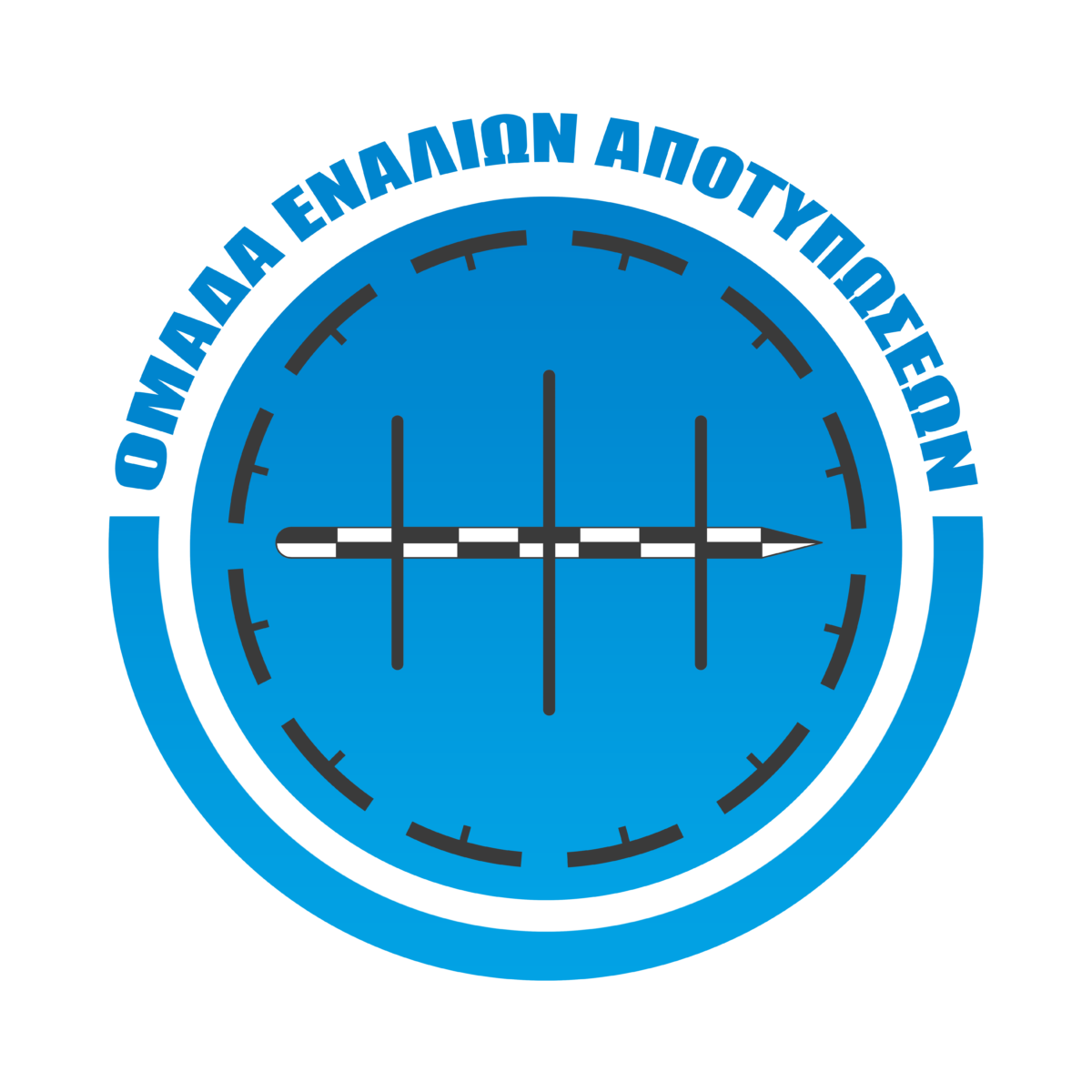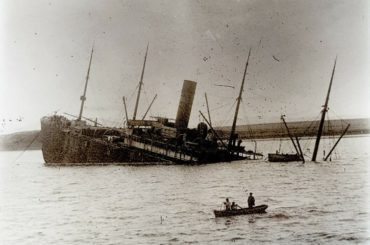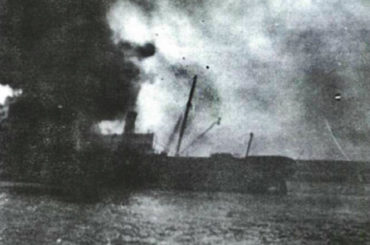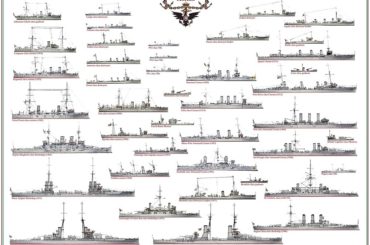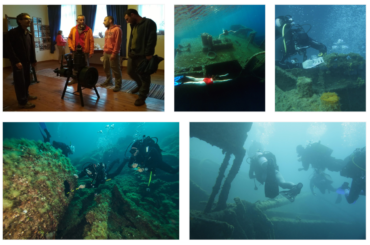The PANAGIS was shipwrecked by bad weather in Epanomi, Halkidiki in 1936. It was originally called the OLGA when it was built in Genoa in 1895. It was soon sold to Cie. Maritime Marmara. In 1902, it was purchased by Michael N. Vernikos. At the beginning of the First World War, it was sold again and renamed the FRANCE. In 1923, it was repurchased by Michalis N. Vernikos and renamed the PENELOPI. In 1924, it acquired its final name under the ownership of Captain Gerasimos Fokas.
“Midnight. The PANAGIS struggles with frenzied waves outside the Sithonia peninsula. Pitch black.”
The steamship PANAGIS came to a terrible end. Stranded for four days in stormy conditions, it sank a few meters off the coast of Epanomi on eastern shores of the Thermaic Gulf and three of its crew died in the frigid waters.
The cargo steamship was built in 1895 at the Ansaldo Shipyards in Sestri Ponente, Genoa and named the OLGA by its Greek owners. It was a small ship of 188 gross tonnage measuring 40.7 x 5.8 metres and was driven by a two-cylinder engine. It was soon sold to A.H. Konovalov of Cie. Maritime Marmara, which was based in Odessa. In 1902, it was purchased by Michael N. Vernikos, who lived in Constantinople. The Vernicu family was originally from Sifnos and its members had emigrated to Constantinople in the third quarter of the 19th century. Michalis’ son was later adopted by Eugenios Eugenides and referred to as Nikolaos Vernikos-Eugenides.

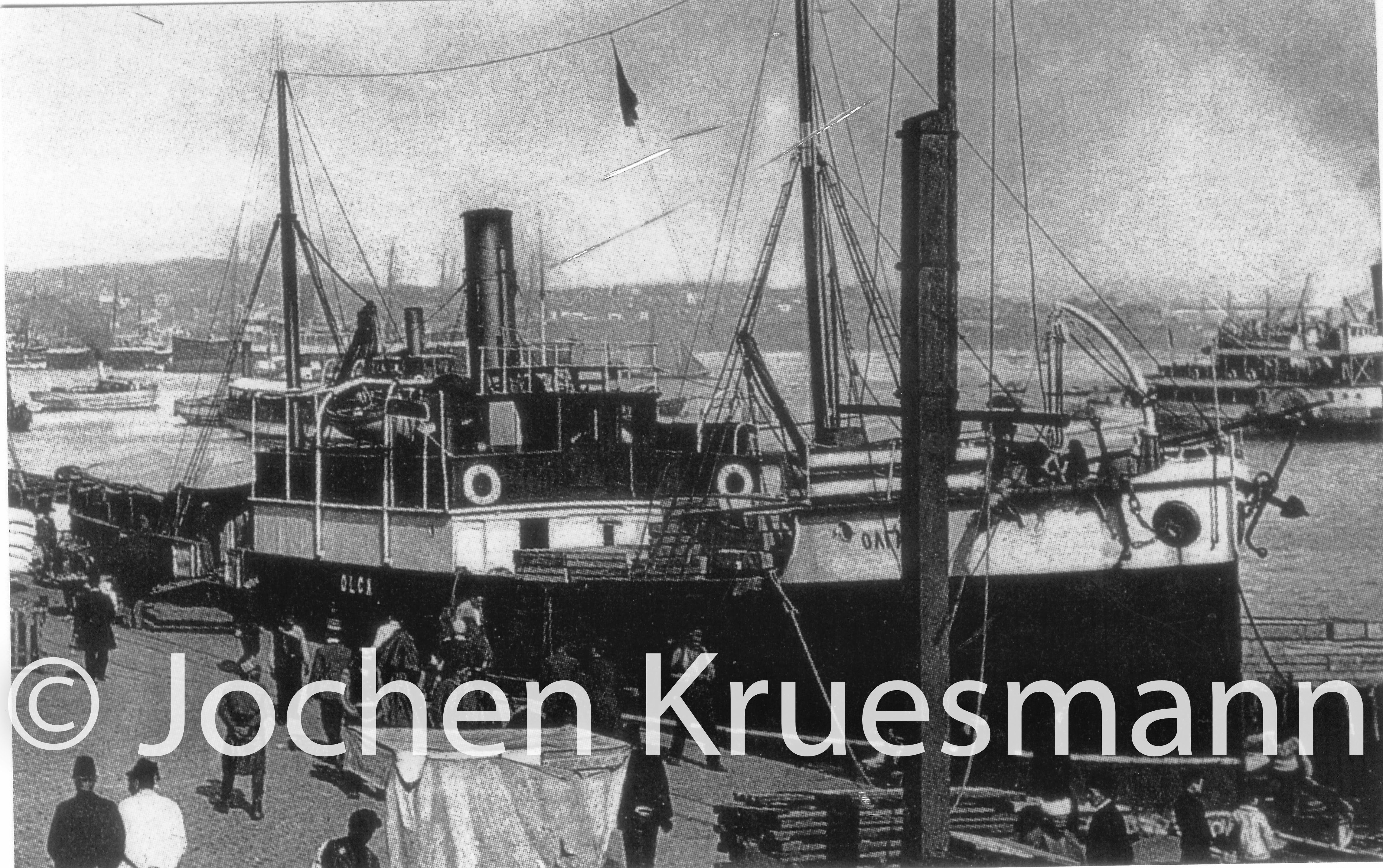
The OLGA in Istanbul (collection J. Kruesmann)
With the onset of World War I, the Vernicu family was in danger of losing ships which could be seized by the Turkish authorities because of their Greek ancestry. In order to retain the ships, Nikolaos transferred his property titles to various Levantines in Constantinople. So, the ship passed to I. Crespin. It bore the name the FRANCE and continued to travel the coastal routes of the Marmara Sea, but under a French flag. In 1923 Mich. Vernikos brought the ship to Piraeus where it was registered (a/a 513) and renamed the PENELOPI. In April 1924, it was bought by Kefalonian Captain Gerasimos Fokas, who operated it independently. In 1929, it was sailed for Fthiotidos Steamship. In 1932, it made occasional trips between Kavala in northern Greece and the nearby island of Thassos.
In an issue of the magazine “Naval Greece” 80 years ago, Dim. Bogris describes a journey with PANAGIS:
«Midnight. PANAGIS struggles with frenzied waves outside the Sithonia peninsula. Pitch black. The air is fading. No port nearby and no lights to guide us. I’m on the bridge with the two captains. They are both wonderful, each in their own way, righteous gods of the sea. They are struggling to make the boat less susceptible to rocketing so as not to disturb the passengers. We could have avoided this adventure, we’d have somewhere to spend the night at least, but you see Captain Gerasimus is very much in charge. Knowing well what serving remote “barren” routes is all about, he persisted. […] And landing the next day at Daphne, I had the best impressions of these brilliant PANAGI people – from the first captain till the last stoker who are fighting late at night with the elements to provide a quiet and comfortable living for their families on land…. »
In another issue of the same magazine, an article entitled ‘Around Halkidiki’ was published where the same columnist describes his meeting with the ship’s officers:Gerasimos Fokas, captain and owner of PANAGIS and Dimitrios Meletii, second captain. “They are both Kefalonians and, of course, so too are almost all the crew of the small boat they rule. It leaves the port of Thessaloniki every Thursday to eventually arrive, after so many stops, in Kavala – the “barren” route – comes from this devastated Ionian island.»
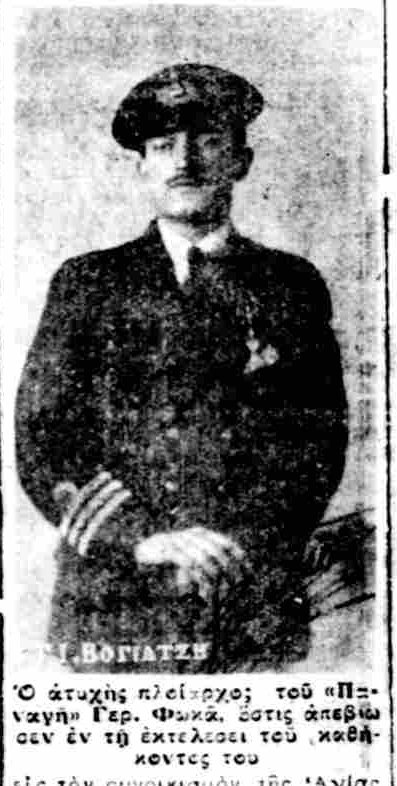
Captain Gerasimos Fokas
On Saturday, February 9, 1936, PANAGIS departed from Thessaloniki to undergo another voyage on the “barren” Halkidiki route, carrying a general cargo in addition to 30,000 tobacco bails. At midnight, it ran aground due to adverse weather conditions, namely thunderstorms and dense fog, despite the Epanomi lighthouse. On Sunday, the rescue boat MIMIS (which has since been tied up on the Tourlos Aiginis seafront since 1941) rushed to its aid, but was unable to assist the vessel due to damage. A barge also sailed and was used to recover some of the cargo PANAGIS had been transporting. MIMIS tried again to approach the next day, but in the meantime a heavy blizzard had set in, causing it to drift and stray. The area had recently been hit by heavy snowstorms and more than ten people had been killed in various maritime accidents. Eventually, after another attempt, the MIMIS was able to detach the stricken vessel. The crew of the PANAGIS remained on board, making superhuman efforts to bail out the water that had flooded into its hull. The blizzard was accompanied by severe thunderstorms, causing waves to sweep the decks and the bridge. The situation on the semi-submerged vessel was truly desperate, prompting some to climb the frozen masts where they stayed all Tuesday night. During the hours of darkness, Captain Fokas and a stoker were killed by cold and exhaustion, while one of the sailors was swept away by the waves and drowned.
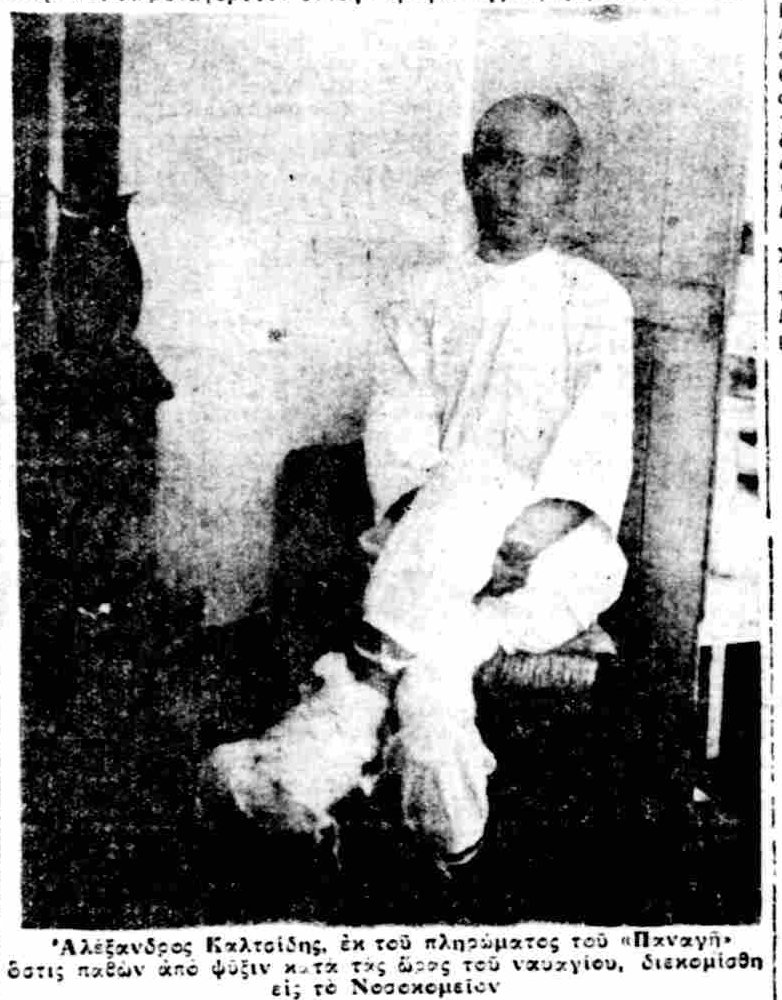
Crew member Alexandros Kaltsidis
The word-of-month story told by the local inhabitants of Epanomi is that some of the PANAGIS crew made it to land, but became disoriented due to blinding snow and fog and eventually died of hypothermia. However, press reports of the day mention that ten crew members of the semi-submerged PANAGIS were saved by the tugboat MIMIS, which managed to reach the wreck on the morning of Wednesday the 12th of February. The newspaper ‘Macedonia’ reports: “Everywhere victims, catastrophe, damage and drama. The greatest drama occurred when the semi-submerged steamship PANAGIS was finally sunk last Saturday after a fierce two-day struggle against the sea and all the elements of nature. The captain and two crew members froze to death during the performance of their duties and their attempt to save the ship and their fellow companions.»
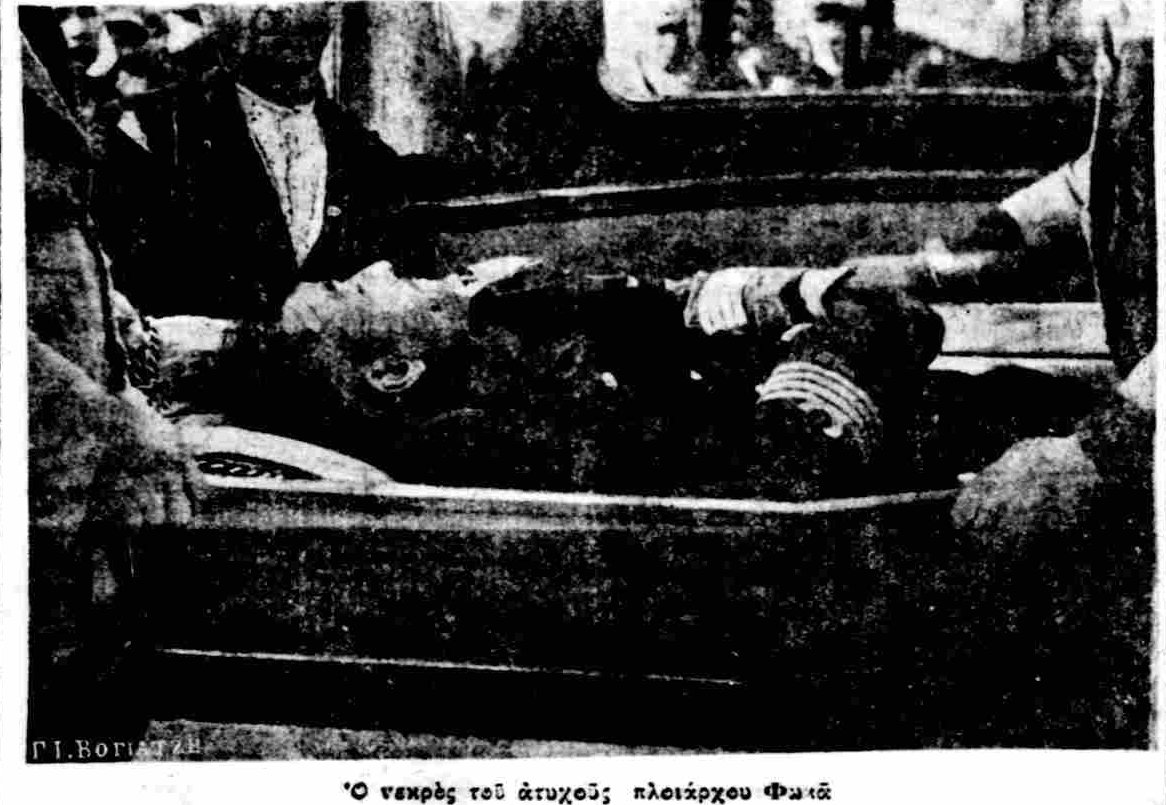
The body of Captain Gerasimos Fokas
The shipwreck was abandoned to the elements of nature, to be looted by the local villagers, in accordance with customary practice. No doubt, parts were stripped and sold as scrap metal. Today, the only remnant is the boiler that is still visible above the sea surface.
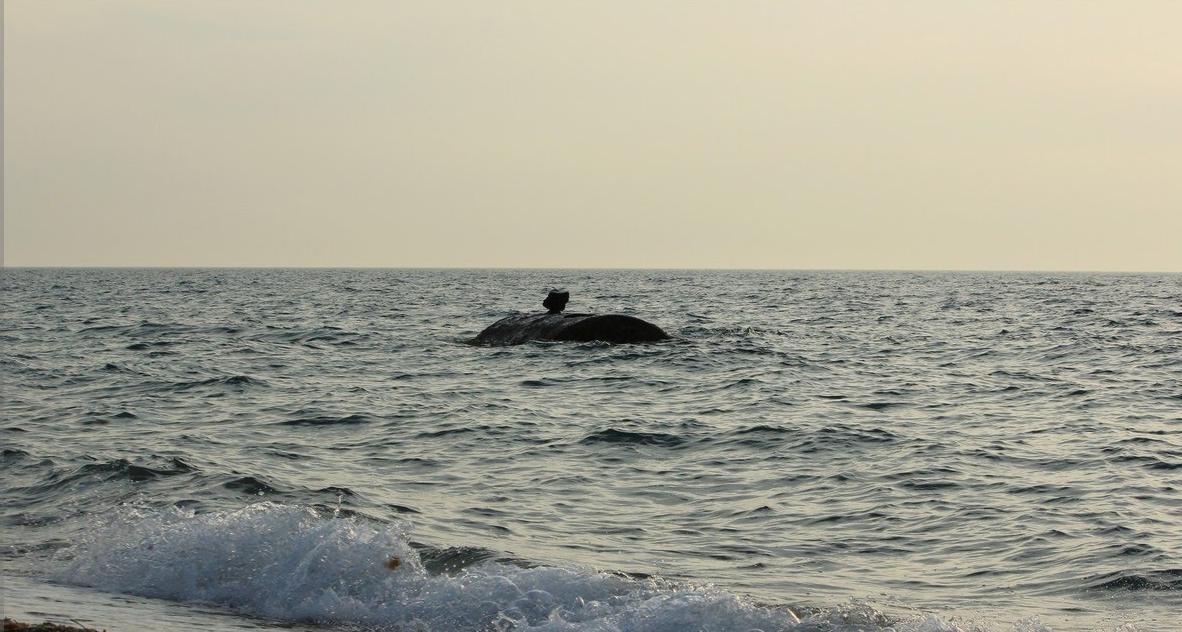
The boiler – present day
[*] Ross J. Robertson is an Australian who has lived in Greece for the past thirty years. He has a BSc (Biology) and is an EFL teacher. He is the co-owner of two private English Language Schools and instructs students studying for Michigan and Cambridge University English Language examinations. He has written various English Language Teaching books for the Hellenic American Union (Greece), Longman-Pearson (UK) and Macmillan Education (UK). He published his debut novel (fiction/humour) entitled ‘Spiked! Read Responsibly’ in 2016. Moreover, he has written several spec screenplays and a number of newspaper articles, including an extensive series on the 75th anniversary of the WWII Liberation of Greece. A keen AOW and Nitrox diver, he is also a shipwreck and research enthusiast and has written features for UK Diver Magazine, US Diver and the Australian newspaper, Neos Kosmos. Ross continues to combine his expertise in English with his love of storytelling and local WWII history to produce exciting materials.
